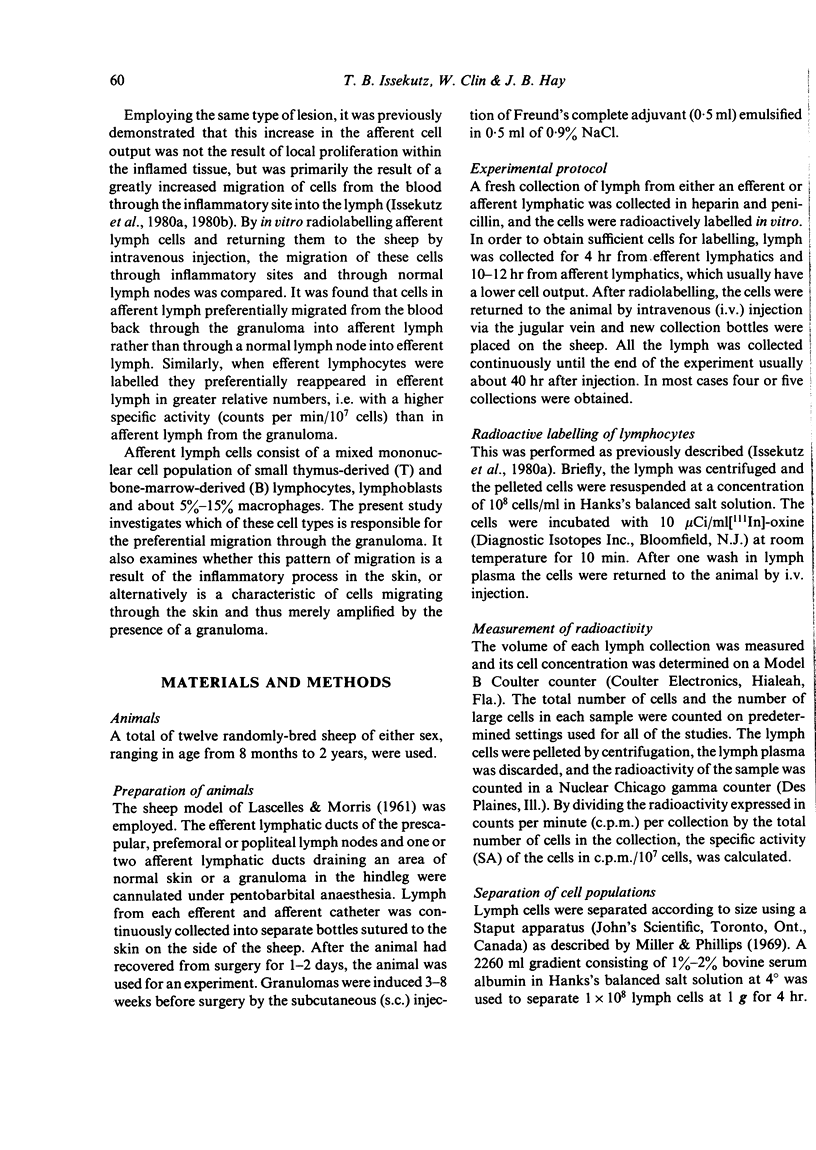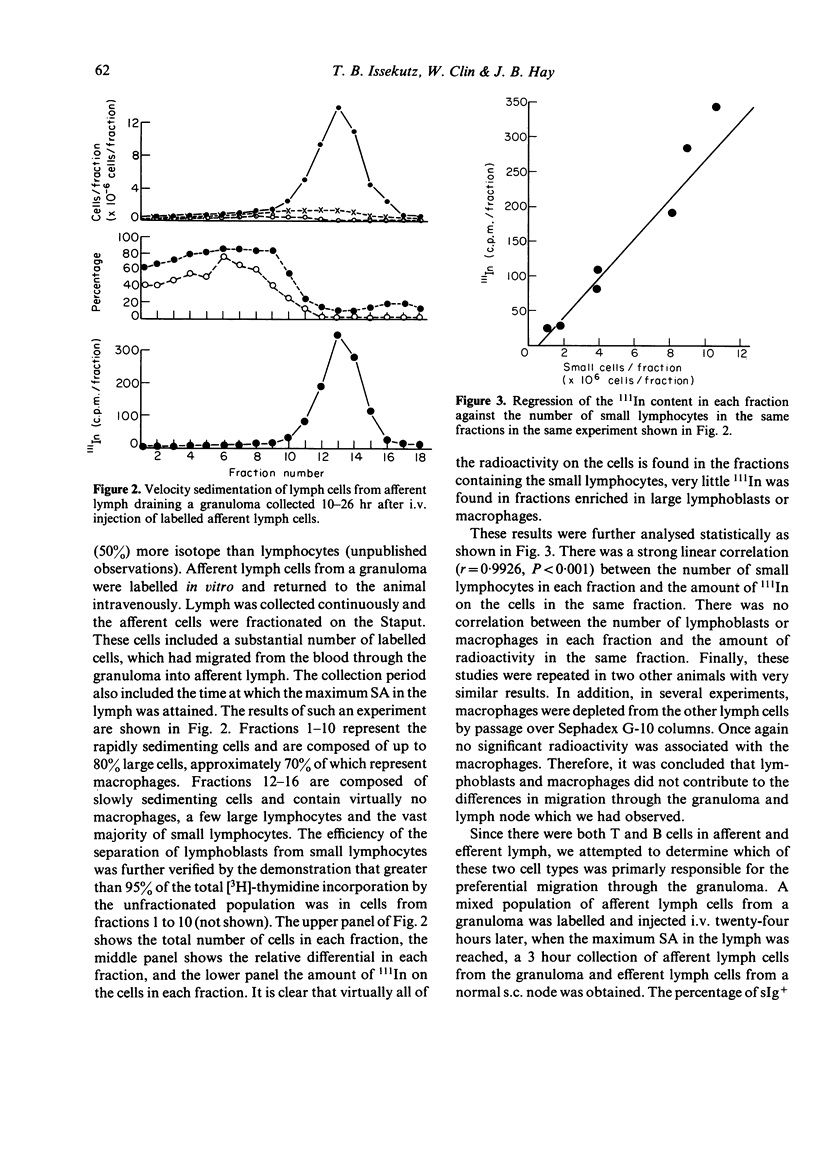Abstract
Afferent lymphatics draining Freund's adjuvant-induced granulomas and efferent lymphatics from normal subcutaneous lymph nodes were cannulated in sheep. It was previously reported that cells collected from these lymphatics, after being radiolabelled with 111In and returned to the animal intravenously, migrated from the blood back through the granuloma or lymph node into the lymph compartment from which they were originally obtained. Afferent lymph cells preferentially migrated out of the circulation in the granuloma rather than the lymph node. The cell responsible for this selective migration was found to be a small recirculating T lymphocyte. Macrophages and lymphoblasts did not demonstrate this migration. Similarly, B cells did not contribute to the lymphocyte migration observed. The migration of lymphocytes through normal uninflamed skin was examined. Afferent cells migrated through normal skin in the same way as through a granuloma, suggesting that neither antigen nor local inflammatory changes were responsible for this migration.
Full text
PDF







Selected References
These references are in PubMed. This may not be the complete list of references from this article.
- Butcher E. C., Scollay R. G., Weissman I. L. Organ specificity of lymphocyte migration: mediation by highly selective lymphocyte interaction with organ-specific determinants on high endothelial venules. Eur J Immunol. 1980 Jul;10(7):556–561. doi: 10.1002/eji.1830100713. [DOI] [PubMed] [Google Scholar]
- Cahill R. N., Poskitt D. C., Frost D. C., Trnka Z. Two distinct pools of recirculating T lymphocytes: migratory characteristics of nodal and intestinal T lymphocytes. J Exp Med. 1977 Feb 1;145(2):420–428. doi: 10.1084/jem.145.2.420. [DOI] [PMC free article] [PubMed] [Google Scholar]
- Cahill R. N., Poskitt D. C., Frost H., Julius M. H., Trnka Z. Behaviour of sheep-immunoglobulin-bearing and non-immunoglobulin-bearing lymphocytes isolated by nylon wool columns. Int Arch Allergy Appl Immunol. 1978;57(1):90–96. doi: 10.1159/000232088. [DOI] [PubMed] [Google Scholar]
- Cahill R. N., Poskitt D. C., Hay J. B., Heron I., Trnka Z. The migration of lymphocytes in the fetal lamb. Eur J Immunol. 1979 Mar;9(3):251–253. doi: 10.1002/eji.1830090315. [DOI] [PubMed] [Google Scholar]
- Chin W., Hay J. B. A comparison of lymphocyte migration through intestinal lymph nodes, subcutaneous lymph nodes, and chronic inflammatory sites of sheep. Gastroenterology. 1980 Dec;79(6):1231–1242. [PubMed] [Google Scholar]
- Ford W. L., Simmonds S. J. The tempo of lymphocyte recirculation from blood to lymph in the rat. Cell Tissue Kinet. 1972 Mar;5(2):175–189. doi: 10.1111/j.1365-2184.1972.tb01014.x. [DOI] [PubMed] [Google Scholar]
- Hay J. B., Hobbs B. B., Johnston M. G., Movat H. Z. The role of hyperemia in cellular hypersensitivity reactions. Int Arch Allergy Appl Immunol. 1977;55(1-6):324–331. doi: 10.1159/000231943. [DOI] [PubMed] [Google Scholar]
- Issekutz T. B., Chin G. W., Hay J. B. Lymphocyte traffic through chronic inflammatory lesions: differential migration versus differential retention. Clin Exp Immunol. 1981 Sep;45(3):604–614. [PMC free article] [PubMed] [Google Scholar]
- Issekutz T. B., Chin W., Hay J. B. Lymphocyte traffic through granulomas: differences in the recovery of indium-111-labeled lymphocytes in afferent and efferent lymph. Cell Immunol. 1980 Aug 15;54(1):79–86. doi: 10.1016/0008-8749(80)90191-4. [DOI] [PubMed] [Google Scholar]
- Issekutz T., Chin W., Hay J. B. Measurement of lymphocyte traffic with indium-111. Clin Exp Immunol. 1980 Jan;39(1):215–221. [PMC free article] [PubMed] [Google Scholar]
- Julius M. H., Simpson E., Herzenberg L. A. A rapid method for the isolation of functional thymus-derived murine lymphocytes. Eur J Immunol. 1973 Oct;3(10):645–649. doi: 10.1002/eji.1830031011. [DOI] [PubMed] [Google Scholar]
- LASCELLES A. K., MORRIS B. Surgical techniques for the collection of lymph from unanaesthetized sheep. Q J Exp Physiol Cogn Med Sci. 1961 Jul;46:199–205. doi: 10.1113/expphysiol.1961.sp001536. [DOI] [PubMed] [Google Scholar]
- Ly I. A., Mishell R. I. Separation of mouse spleen cells by passage through columns of sephadex G-10. J Immunol Methods. 1974 Aug;5(3):239–247. doi: 10.1016/0022-1759(74)90108-2. [DOI] [PubMed] [Google Scholar]
- Miller R. G., Phillips R. A. Separation of cells by velocity sedimentation. J Cell Physiol. 1969 Jun;73(3):191–201. doi: 10.1002/jcp.1040730305. [DOI] [PubMed] [Google Scholar]
- Pedersen N. C., Morris B. The role of the lymphatic system in the rejection of homografts: a study of lymph from renal transplants. J Exp Med. 1970 May 1;131(5):936–969. doi: 10.1084/jem.131.5.936. [DOI] [PMC free article] [PubMed] [Google Scholar]
- Sprent J. Circulating T and B lymphocytes of the mouse. I. Migratory properties. Cell Immunol. 1973 Apr;7(1):10–39. doi: 10.1016/0008-8749(73)90180-9. [DOI] [PubMed] [Google Scholar]


